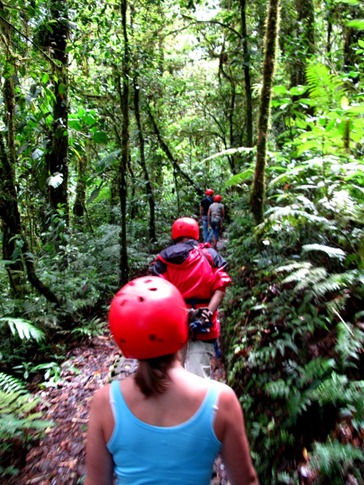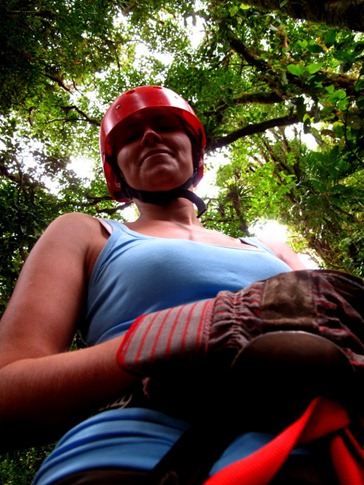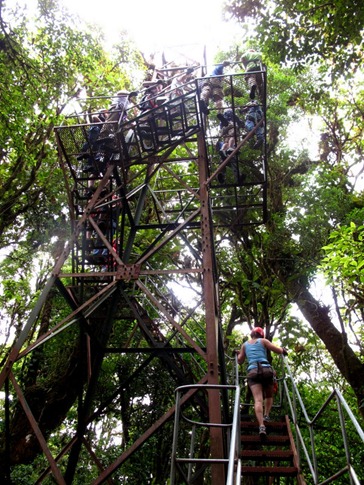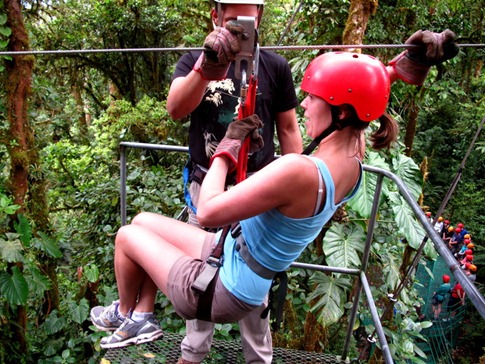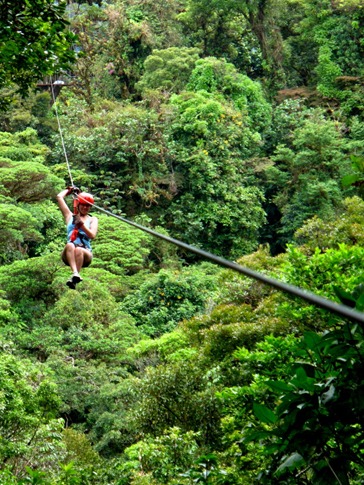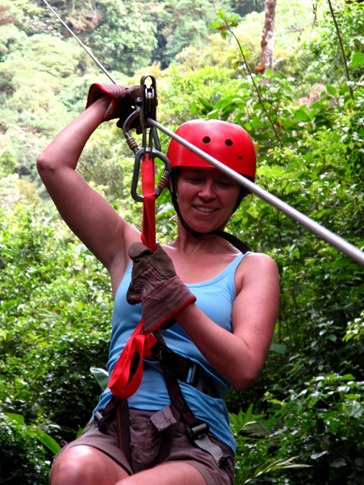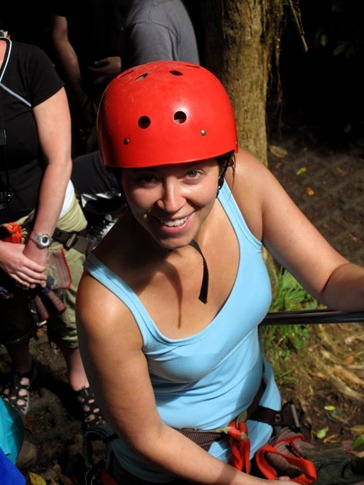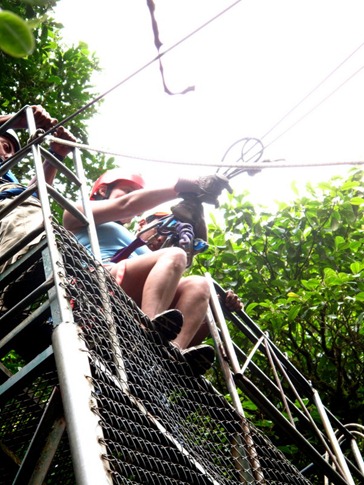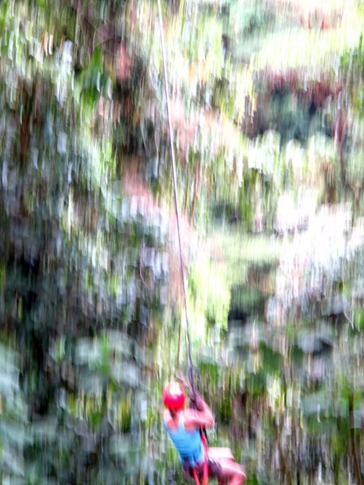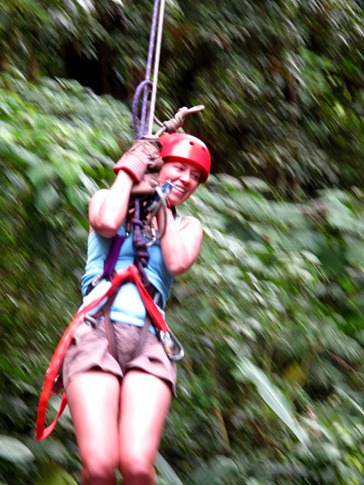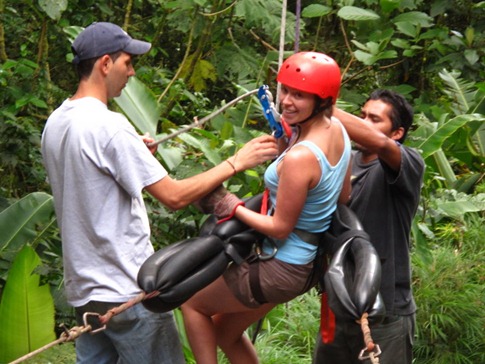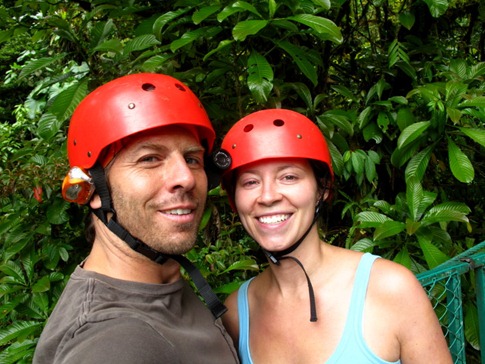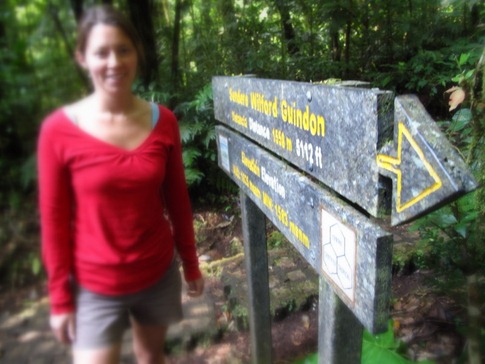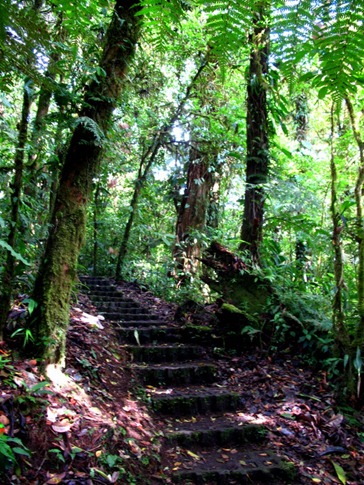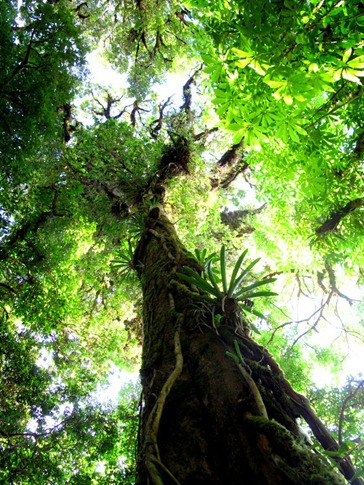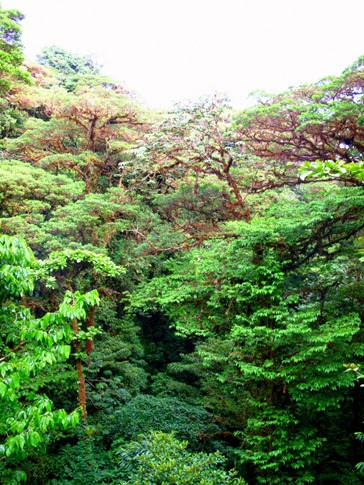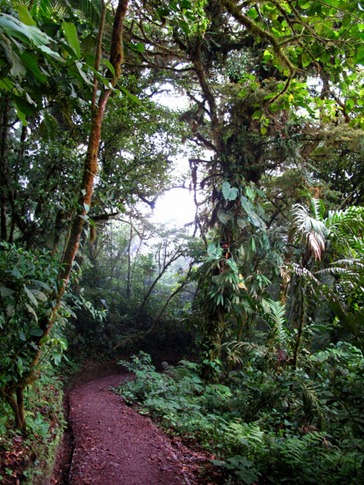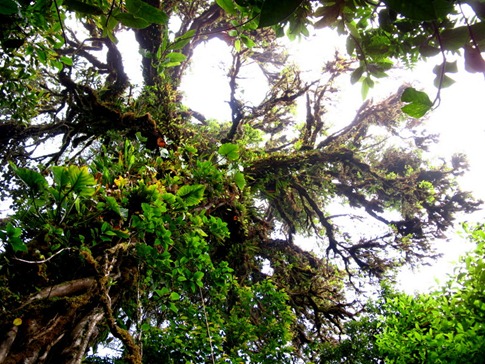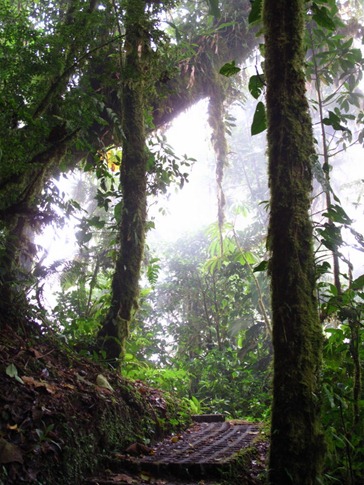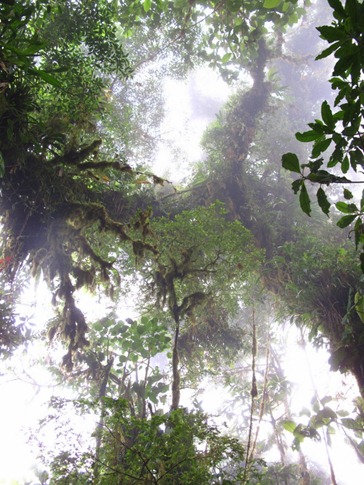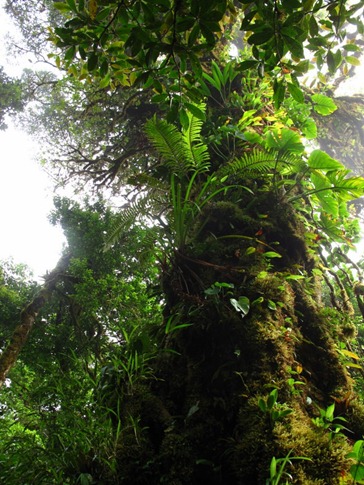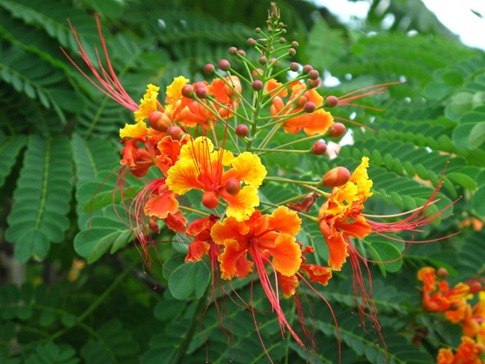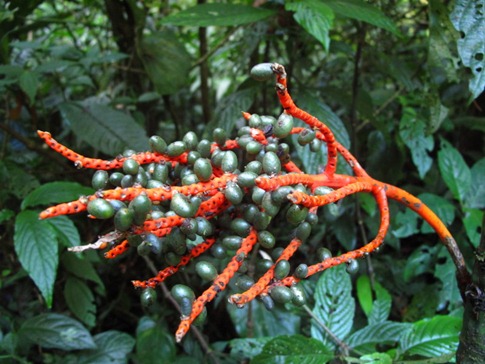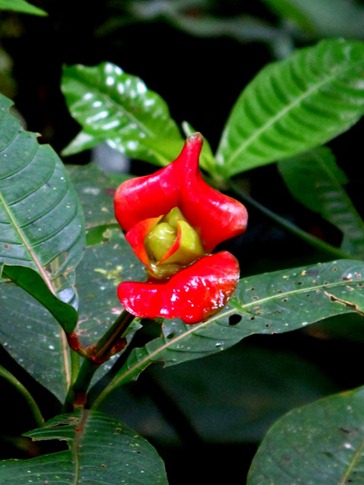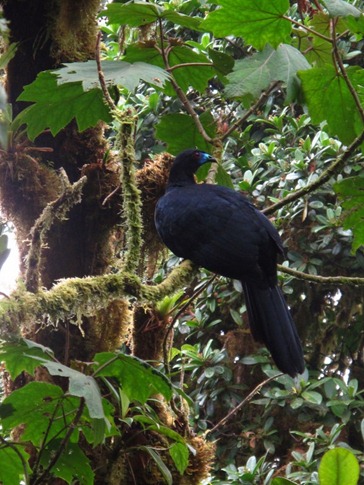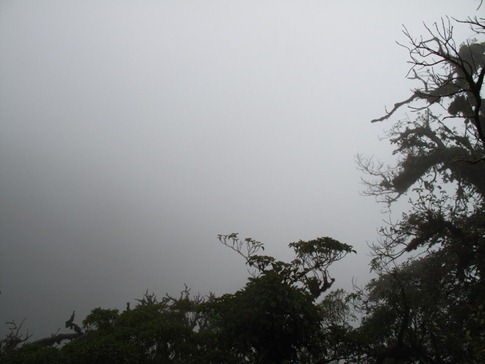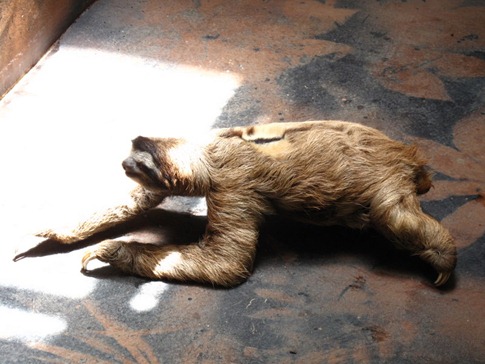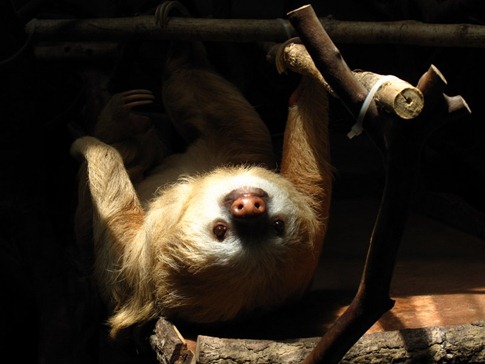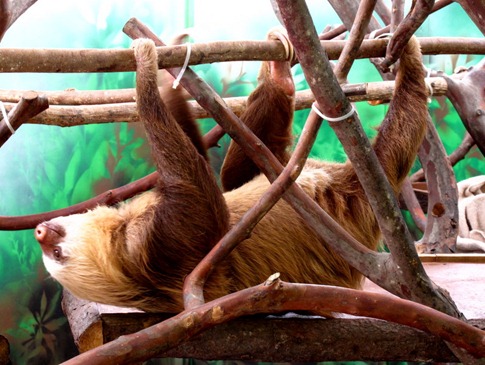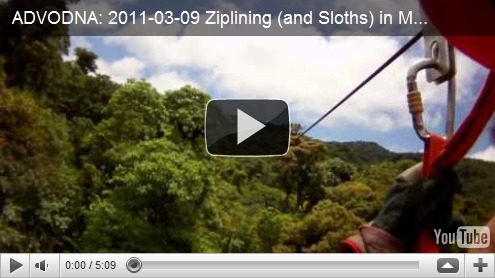Today we set out for the full-on tourist day in Monteverde. Why fight it? And in the end, we didn’t regret it.
It seems like everyone who goes to Costa Rica goes ziplining. It’s a verb. Look it up. Okay, don’t look it up but anyone you talk to will tell you it was invented here. In fact, a Canadian who started one of the first zipline companies in Costa Rica has successfully patented the idea. Of course, no one respected the patent, claiming that locals and indigenous peoples had been doing something similar for centuries, and the government has frozen it. Big deal, I always thought. So you whiz along a cable between two trees. How fun is that? And what are you really gonna see in between two trees in someone’s back yard? At the recommendation of the owners of the Cala Lodge, we went to the Selvatura Park to find out.
With 3km of cables spanning a huge area of primary growth forest, Selvatura is said to be the largest park down here. It’s at the end of a rough dirt road near the Santa Elena Reserve, determined to be a unique ecosystem from the Monteverde Reserve because of a few degrees in temperature differential that results in a variety of new species. Still, just when we’d start to feel glad we had our big, beefy 4x4 truck, we’d meet either a rental Suzuki Jimmy or a huge, modern tour bus coming the other direction. The reception area was packed with tourists browsing the gift shop, but everyone was very helpful and nice. We paid our $45 each - the credit card hasn’t seen this much action in a long time – and got fitted with helmets, gloves and harnesses with pulleys and a safety cord. We loaded into a waiting van with 15 or so others z-liners – it’s gonna be a thing – and headed up the hill. It would presumably be all downhill from there.
After a brief safety talk with info about braking – about slowing down, not about the cables breaking – we wound up a staircase to a landing. One by one, with us the last of the group of course – we need to start cultivating our “me first” tourist instincts like “the hogs” – our safety was clipped in, pulley fixed on the cable and harness attached to the pulley.
With a sound like a zipper – hey they should call this… oh, nevermind – you started off slowly. The pace picked up quickly as the forest floor seemed to drop away. Soon, trees flew by on either side, obviously trimmed to allow passage, but not by much. There was a moment when you’d think, “Okay, this is fast enough.” The frequency of the sound would rise and you’d see the landing platform coming into view ahead of you. You;d remember the last words you heard, “Don’t brake until you see the sign from the guide at the other end.” Seemingly seconds too late, he’d put up his hands and you’d press the thick leather palms of the glove against the cable behind the pulley. Still the “catch” was dynamic, and it took a second to realize you’d stopped and were on a stable, metal platform secured high in the trees. Before you knew it, you’d be clipped into the next one; 12 more to go.
The course seemed to go on forever including one cable that was 500 meters. Though some question just how “low impact” this large of an operation could possibly be, it really was an amazing way to see the forest. Sometimes in the darkness between the trees and sometimes above looking down from above at the dense canopy, you felt like a monkey swinging through the jungle. But I’ll come back to that…
The final ride was something they called “the Tarzan Swing.” Starting from a platform 25 feet high, we were clipped into a rope suspended to a tree probably 200 feet above. We watched as the entire group stepped off the platform and took the ride, some screaming at the speed of the swing and some (mostly the men) grunting as the harness came snug after a brief (no pun intended) free fall. Our position at the end of the line allowed us to perfect our approach; lean back against the line and bend your knees. If you jumped out, you’d land with a sharp tug as the static line caught you. This may be a form a Costa Rican natural selection.
Z-lining (see I told you) was actually kind of a highlight for us. Just the right mix of adrenaline, natural beauty and a feeling that we were safe but that they still probably shouldn’t be letting people do this.
As you can see from above, I put my HD helmet cam to good use although everyone was very confused as to why I had a headlamp coming out of my ear; I was just using the strap for the camera. I’m always really happy with the quality of this little camera. You can see it in action in the Into the Jungle with NoLimitX video as well as tons of videos from us riding a motorcycle this Summer in France. But you’re still going to have to keep reading (or let’s be honest, scroll down) to see it in action on the zipline…
In the afternoon, we drove up to the Monteverde Cloud Forest Reserve. On the dirt road, we came across a family who was staying at the same lodge coming down the hill in, you guessed it, a Suzuki Jimmy. They had turned around because there was some road work ahead and someone had stopped them but they couldn’t understand what he’d told them in Spanish. We drove up the road and learned that he’d just told them to wait for a couple minutes while a big bulldozer came down the hill. Have I mentioned, learn Spanish if you’re considering this trip?
The owners of our lodge had told us that while mornings were best for seeing wildlife at the reserve, they were also when the tour buses went. Preferring no animals to herds of the human kind, we arrived at 3:30, knowing that they don’t let anyone in after 4. We paid our fee - something like $17 I think- were shown a short loop and warned that we had to be back by 5 when they closed. Feeling the need for some exercise after a relatively sedentary few months, we set off at a brisk pace on a loop the map said would take 2 hours, figuring we could shave a half hour off the average tourist time.
After a half an hour of climbing through beautiful forest, thick with life growing on top of life, the air turned cooler and mist started to appear in the trees. We were reaching the cloud forest.
With so much moisture in the air, vegetation went into overdrive, a thick tapestry of ferns, moss, vines, grasses and trees. And those kinds of flowers where you just have no idea why nature would evolve them to look like they do. But at the same time, we’ve seen similar ones in Belize and El Salvador, so there must be a reason.
And we did manage to spot one bird, although we have no idea what it was. I know Quetzals are brightly colored. Aw, what the hell? Let’s just call it a Quetzal (it’s not).
The scenic vista was the turnaround point for our brisk hike if we were to get back before 5. The view was, well… clouds and forest, so I guess we got what we paid for at the cloud forest reserve.
On the way out of town the next morning, we had one more stop to make at a sloth rescue center. After paying our tens of thousands of Colones, yep about $20 again, we met our guide and were shown a quick movie with some general information about sloths and the rescue center. Unfortunately, the narrator insisted on pronouncing it “slowth.” Then, to really drive his point home, acknowledged that while some people say “slawth,” “bawth” are correct. Yes, he said “bawth.”
The center was started after some local girls brought an injured sloth – can we agree to say “slawth?” – to a gringo couple living in the area. They nursed her back to health and before they knew it, people started bring them more hurt animals. As the canopy is cleared for agriculture, grazing or development, sloths no longer have safe routes around their habitat. You think they’re slow in the trees, you should see them on the ground or trying to cross a road (you will below). In their confusion, they’ll sometimes climb power lines and burn their claws. Believe it or not, sloths are also common targets for teenagers throwing rocks or generally harassing them. Fortunately, something about their slow metabolism (they only defecate once a week) makes them resilient, and they can often recover to be released into the wild.
Though more closely related to bears and anteaters than monkeys, sloths spend all their time in trees, moving with slow calculated movements between branches. There are two varieties: three-toed that are a little smaller and thinner and two-toed that are more solid with an upturned “pig nose.” We spent about an hour watching these guys at the center, and they never ceased to freak us out. One particular female three-toed sloth was incredible inquisitive and would use the extra vertebrae in her neck to take full advantage of her 370 degree range of motion while looking over her shoulder at us. The markings on her face looked painted-on, like a cross between a clown and an owl and had to be the inspiration for George Lucas’ Ewoks.
For some reason, this pose reminded me of “The Jungle Book.” Wait for it…
The outgoing female insisted on climbing down her tree and crawling awkwardly on the floor.
At first it was cute, but it quickly became pretty pitiful when you thought about her trying to make it across a road.
Still she kept looking up at us like “Heh? I’m the whole package right? Look at me go!”
Around the corner, the two-toed sloths looked a little more like the bear ancestors.
These little guys just had so much personality. Pictures just don’t do them justice. So for your patience, you shall be rewarded. Check them (and us!) out in action…

